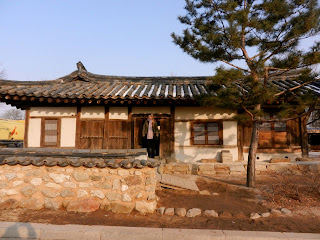Gueongbokgung Palace is one of 5 palaces in the Seoul area.
This is the exterior gate.
These soldiers reminded me of the soldiers at the Buckingham Palace because they didn't move and stood as still as a statute.
This is the ceiling of the entrance gate.
The entrance into the main area of the Palace where the King resided.
Fancy Drum
Joanna, she was being pulled in by the forces of the drum.
inside the gated area is where only the King could walk on the steps it is a sacred area off limits to anyone to step foot on except royalty.
It looks like an eternal hall.
The Throne building
The mighty throne! Do you think they liked the colors red, blue, and green?
Joanna and I on royal ground.
This is where the Queen hung out.
The mountain was really pretty behind the property.
To keep the trees warm in the winter they wrap the trees up.
The detail to the architecture is really pretty and nice.
Quiz: Why are there stoves underneath the floors of the buildings?
Answer: They are fire places. The floors are made of stone so they heat the floors from the fire places and then the heat rises and warms the rooms.
Then you ask, but where does the smoke go?
The dig tunnels under the ground to let the smoke escape through the tunnels that general have a chimney built into a nearby fence and that is where the smoke comes out.
Brilliant if you ask me, why don't we heat our floors?
On one of the fences there was this cat just hanging out basking in the sun.
Joanna and I standing across from the dance hall that is in the middle of a pond.
What a pretty view.
I want to go for a ride in that boat.
It was interesting to see part of the ponds frozen over and then another section thawed out with ducks playing in the water.
If you notice this building looks a bit different from the Palace buildings.
What is different about this building? The structure? No, it is the colors. The Royal family is the only ones who got the red, green and blue colors. Noble families who also lived on the Palace grounds had plain colored houses.
Double layers of fence.
Backside of the Palace grounds. From here if you keep going is how you would get to the President's house.
The museum.
The Korean's have very beautiful pottery.
Would you like to have a grass coat?
Traditional dolls
Basket weaving.
Marionette dolls.
This is a depiction of a kimchi cooking day. They do all different kinds of kimchi.
Each mask represents something different.
Snake Guardian.
It is the year of the Snake!
Traditional bedding.
I had the whole Korean experience complete with sleeping on the floor.
Taboo Line
When a baby was born, a special straw rope called "Geumjul" was hung across the gate of the house to announce its birth together with its gender. For a boy the rope was inserted with red peppers and charcoal. For a girl it had charcoal and pine twigs. The rope was believed to drive away evil spirits and any impure visitors. It was removed 21 days later.
My knees would get tired after a few minutes on my knees let along all day in school.
The placenta of a newborn baby was carefully stored as it was believed to contain the baby's vital energy. In the royal or noble households a baby's placenta was contained in a jar and placed in a special underground chamber (Taesil) in the mountains. An auspicious day was picked by divination for this task. The commoners covered a placenta with chaff and burned it. Some just buried it in a clean spot.
Traditional wedding party.
The women would ride in this taxi.
This was for the King.
This is a Sixtieth Birthday Feast
A parent's 60th birthday was celebrated with a large feast and merrymaking. As an expression of their filial affection and gratitude, the children prepared a special table laden with piles of colorful fruits and delicacies, often decorated with letters symbolizing longevity. Different to the table for ancestral rites, the husband sat to the east and the wife to the west at the 60th birthday table (Hoegap-sang). They received wine and obeisance from all their children and grandchildren and their spouses as well as their relatives, in order by age, wishing them health and longevity.
Bier
The biers (Sang-yeo) used for conveying the corpse to the burial site resembled palanquins, having long poles on both sides to be shouldered by 12 to 24 pallbearers. Most villages had such a bier for common use. It was designed to be disassembled for storage in a house removed a short distance from the neighborhood.
Rooster is my symbol from the Chinese Calendar.
Traditional house at the museum.
Outside of the Palace across the street is a statue of the King Sejong the Great. He is one of two people in the Korean history who wore the title the Great.
Sejong did many great things during his reign.
Science and Technology
Sejong is credited with technological advances during his reign. He wanted to help farmers so he decided to create a farmer's handbook. The book-the Nongsa jikseol- contained information about the different farming techniques that he told scientists to gather in different regions of Korea. These techniques were needed in order to maintain the newly-adopted methods of intensive, continuous cultivation in Korean Agriculture.
Sejong also wanted to reform the Korean calendar system, which was at the time based upon the longitude of the Chinese capital. Sejong, for the first time in Korean history, had his astronomers create a calendar with the Korean capital of Seaoul as the primary meridian. This new system allowed Korean astronomers to accurately predict the timing of solar and lunar eclipses.
Literature and Agriculture
Sejong supported literature, and encouraged high class officials and scholars to study a the court. King Sejong created the written language of hangul and announced it to the Korean people in the Hunminjeongeum, meaning 'The verbally right sounds meant to teach the people.'
Sejong depended on the agricultural produces of the farmers, so he allowed them to pay more or less tax according to fluctuations of economic prosperity of hard times. Because of this, farmers could worry less about tax quotas and work instead of surviving and selling their crops. Once the palace had a significant surplus of food, King Sejong then distributed food to poor peasants or farmers who needed it. In 1429 Nongsa-jikseol was compiled under the supervision of King Sejong. It was the first book about Korean farming, dealing with agricultural subjects such as planting, harvesting and soil treatment.
King Sejong the Great profoundly affected Korean history with his introduction of hangul, the native phonetic alphabet system for the Korean Language.
Before the creation of Hangul, only members of the highest class were literate (Hanja was typically used to write Korean by using adapted Chinese characters, while Hanmun was sometimes used to write court documents in classical Chinese). One would have to learn the quite complex hanja characters in order to read and write Korean. Further, despite modifications to the Chinese characters, hanja could prove cumbersome when transcribing the Korean language, due to considerable differences in grammar and sentence order. While creating the alphabet, King Sejong encountered opposition of courtiers.
King Sejong presided over the introduction of the 28-letter Korean alphabet, with the explicit goal being that Koreans from all classes would read and write. Each hangul letter is based on a simplified diagram of the patterns made by the mouth, tongue and teeth when making the sound related to the character. Morphemes are built by writing the characters in syllabic blocks. His intention was to establish a cultural identity for Korea through its unique script. The blocks of letters are then strung together linearly.
First published in 1446, anyone could learn Hangul in a matter of days. Persons previously unfamiliar with Hangul can typically pronounce Korean script accurately after only a few hours study.
This is etched into the stone. It has incredible detail to it.
I felt like royalty sitting on a throne.
Traditional musical instruments
A replicated warrior ship.
Men working hard on the ship.
I really enjoyed seeing this type of Korea. I really don't like the city to much but seeing the culture part of the city and learning the history, is what is up my alley.









































































No comments:
Post a Comment